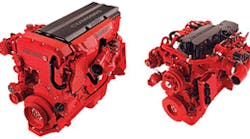ST. PETERSBURG, FL. Cummins gave reporters an overview of how its heavy- and medium-duty 2007 engines will differ from its current models as the engine maker prepares to roll out several “beta prototypes” to select truck manufacturers this month for final testing.
Jeff Weikert, executive director of mid range engineering, noted that the medium-duty product line for 2007 will include a new beefed-up 6.7-liter ISB, replacing the current 5.9-liter platform. The ’07 ISB will offer 325 hp and 750 lb-ft of torque – an improvement over current ISBs by 50 ponies and 90 lb-ft. He also said Cummins’ ISC (330 hp, 1,000 lb-ft of torque) and ISL (365 hp and 1,250 lb-ft of torque) will be equipped with the same exhaust gas recirculation technology (EGR) currently used on the ISB platform.
Weikert added that 170 beta prototypes of Cummins’ entire mid-range line are scheduled for production starting this month, with 150 earmarked for fleets in the U.S. and Canada and 20 for the engine maker's engineering research team. This follows 2.5-million miles of total medium- and heavy-duty ’07 engine testing that began in May 2005 across multiple truck applications – delivery vans and utility trucks plus tankers, heavy haulers, garbage and dump trucks as well as LTL and TL applications, he said.
“These [beta] engines represent the final validation of our 2007 process,” Weikert noted here during a news conference ahead of the Technology & Maintenance Council’s annual meeting. “The results so far from our field tests are better than I thought they would be – especially in terms of how much active regeneration of the DPF needed to undergo. We didn’t need much active regeneration to keep the filters clean; and the less active regeneration we have, the better off we are in terms of fuel economy.”
Other key changes for Cummins ’07 mid-range line, said Weikert, are a bigger 18-quart oil pan to allow for oil drain intervals to be extended to 20,000 miles, a new “coalescing filter” to clean crankcase emissions that needs to be replaced every third or fourth oil change, optional electronic oil level sensors, and an optional compression brake for the ISC platform.
On the heavy-duty side, however, Cummins was more circumspect about ratings for the ’07 ISX and ISM platforms. Yet Steve Charlton, the company’s executive director of heavy-duty engineering, stressed that ratings won’t be reduced for the heavy-duty lineup.
The engine maker stressed that the Cummins ’07 ISX engine has no additional subsystems other than a coalescing filter to clean crankcase emissions and an exhaust dosing injector in the turbocharger to add minute droplets of fuel to the exhaust stream for active regeneration. “Other than that, the ’07 ISX looks a lot like the ’02 ISX, with the exact same base engine design,” Charlton noted. “The stability of the base engine design, we think, gives us much better reliability.”
For the ’07 ISM, all the emission-related components – including the EGR cooler, variable geometry turbo (VGT), and coalescing filter – will all be on one side of the engine for easier maintenance, he said.
“The heart of our [‘07] engine system is VGT, and the heart of our aftertreatment system is a diesel oxidation catalyst (DOC) and DPF,” he said. “System integration is the key to success, especially for maintaining fuel consumption comparable to current levels. So incremental improvements for the ISX and ISM for 2007 include an electric actuator for the VGT to provide faster response and improved precision in adjusting airflow to the engine, improved EGR subsystem with a high-performance cooler, and a faster electronic control module (ECM).”
Both Weikert and Charlton emphasized that DPF service internals, to remove ash build up, are going to range between 200,000 and 400,000 miles for both its medium- and heavy-duty engine lines, depending on the vehicle’s duty cycle, or 6,000 hours for a typical urban bus. Both said the filter Cummins plans to use for its medium- and heavy-duty products is designed to last the life of the engine.
Charlton added that only one DPF is going to be required for the engine, no matter the application or rating. “If, for example, an owner-operator wants to stay with a twin-exhaust stack style, we’ll use a horizontal DPF placed under the sleeper to clean the exhaust before the stream splits,” he noted.
Cleaning the filter itself is going to require a special machine, but Jeff Jones, Cummins vp-sales and marketing, said with the potential for a 400,000 mile service interval, most fleets won’t need to get cleaning done during the ownership life of their trucks.
Cleaning itself doesn’t take long, he said – 30 minutes on average, not including the time to remove and then replace the filter on the vehicle. The filter-cleaning machine has a five-gallon bucket for ash collection, which should take 30 to 40 filter cleanings to fill.
Jones added that Cummins expects a total of 1,000 distributors and truck dealers to be certified for warranty work by the first quarter of 2007. “We started explaining the certification process in the fourth quarter of 2005 and plan to start sending them certification kits during the second and third quarters this year,” he said. “On the service and support side, we’re a full year ahead of where we typically would be in terms of certification and training on previous product rollouts.”
In short, Cummins believes it is ready for 2007, said Ed Pence, vp & gm-- heavy-duty engine business. “Our 2007 field testing is well ahead of schedule, with field tests jointly conducted with [truck] OEMs and end customers so they could validate the performance of the entire system in real-world conditions and duty cycles,” he said. Both ’07 model medium- and heavy-duty engines will be available for purchase in the fourth quarter this year.




